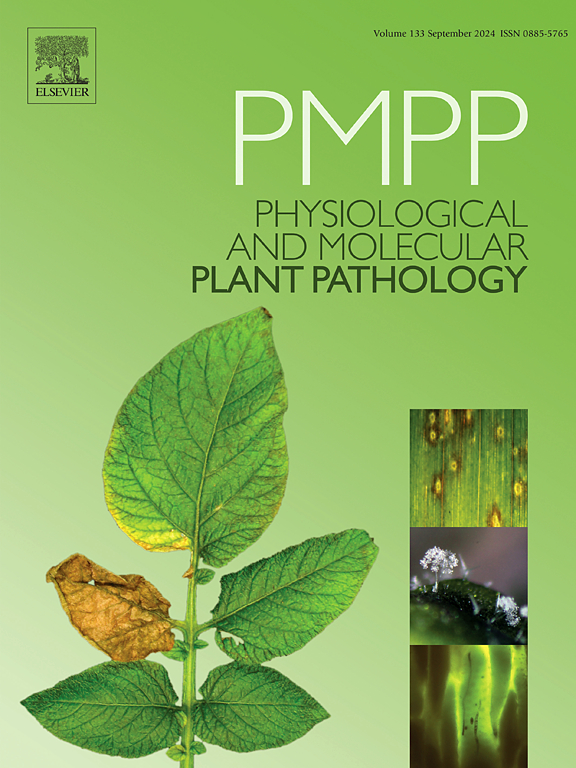东北大豆对茄枯核菌根腐病抗性的全基因组关联研究
IF 2.8
3区 农林科学
Q2 PLANT SCIENCES
引用次数: 0
摘要
由枯丝核菌引起的根腐病对全球大豆生产构成严重威胁。本研究采用全基因组关联研究(GWAS)和转录组学方法鉴定抗性位点。本研究调查了中国北方春大豆自然种群,分别包括2021年和2022年收获的191份和301份。通过严格的疾病指数(DI)阈值鉴定出三种精英抗性基因型。GWAS分析显示48个显著snp分布在14条染色体上,其中ss715599943 (Chr08, PVE = 9.85%)和ss715583097 (Chr02, PVE = 5.69%)表现出最高的表型方差贡献。值得注意的是,2号和18号染色体的抗性位点分布在1.34-1.58 Mb的区域。连锁不平衡(LD)衰变分析鉴定出135个候选基因,包括Glyma.02g252200(编码枯草杆菌样蛋白酶)和Glyma.18g179800(果胶乙酰酯酶),这些基因位于主要snp的20 kb侧区。qPCR的时间表达谱显示了不同的调控模式:Glyma.02g252200表现出显著的上调(3.2倍,P <;0.01),而Glyma.18g179800表现出持续下调(0.4倍,P <;0.05),表明不同的防御机制。功能注释优先考虑了两个与发病相关的候选蛋白:Glyma.04g017200 (leucine-rich repeat receptor kinase,LRR-RK)和Glyma.18g182500 (PR-1家族蛋白)。这些结果提供了:1)标记辅助选择的新分子标记;2)大豆r的机制见解。通过候选基因验证的索拉尼相互作用。本文章由计算机程序翻译,如有差异,请以英文原文为准。
Genome-wide association study on resistance of soybean to Rhizoctonia solani root rot in Northeast China
Root rot caused by Rhizoctonia solani poses a severe threat to global soybean production. This study employed an integrated genome-wide association study (GWAS) and transcriptomic approach to identify resistance loci across. This study investigated a natural population of northern Chinese spring soybean, comprising 191 and 301 accessions harvested in 2021 and 2022,respectively. Three elite resistant genotypes were identified through stringent disease index(DI)thresholds. GWAS analysis revealed 48 significant SNPs distributed across 14 chromosomes, with ss715599943 (Chr08, PVE = 9.85%)andss715583097 (Chr02, PVE = 5.69 %) demonstrating the highest phenotypic variance contributions. Notably, chromosomes 2 and 18 exhibited clustered resistance loci spanning 1.34–1.58 Mb regions. Linkage disequilibrium (LD) decay analysis identified 135 candidate genes, including Glyma.02g252200 (encoding subtilisin-like protease) and Glyma.18g179800 (pectin acetylesterase), within 20 kb flanking regions of lead SNPs. Temporal expression profiling via qPCR demonstrated contrasting regulatory patterns: Glyma.02g252200 showed significant upregulation (3.2-fold, P < 0.01) at 72 h post-inoculation, whereas Glyma.18g179800 exhibited sustained downregulation (0.4-fold, P < 0.05), suggesting divergent defense mechanisms. Functional annotation prioritized two pathogenesis-related candidates: Glyma.04g017200 (leucine-rich repeat receptor kinase,LRR-RK) and Glyma.18g182500 (PR-1 family protein). These results provide: 1)novel molecular markers for marker-assisted selection, 2)mechanistic insights into soybean-R.solani interactions through candidate gene validation.
求助全文
通过发布文献求助,成功后即可免费获取论文全文。
去求助
来源期刊
CiteScore
4.30
自引率
7.40%
发文量
130
审稿时长
38 days
期刊介绍:
Physiological and Molecular Plant Pathology provides an International forum for original research papers, reviews, and commentaries on all aspects of the molecular biology, biochemistry, physiology, histology and cytology, genetics and evolution of plant-microbe interactions.
Papers on all kinds of infective pathogen, including viruses, prokaryotes, fungi, and nematodes, as well as mutualistic organisms such as Rhizobium and mycorrhyzal fungi, are acceptable as long as they have a bearing on the interaction between pathogen and plant.

 求助内容:
求助内容: 应助结果提醒方式:
应助结果提醒方式:


